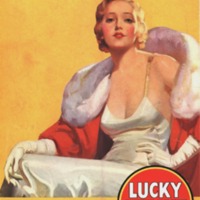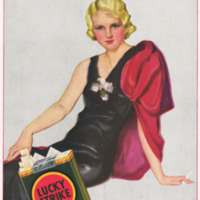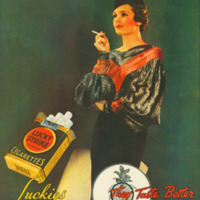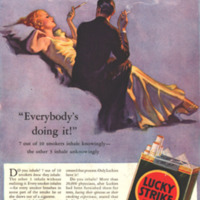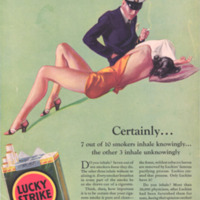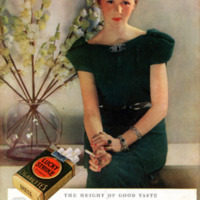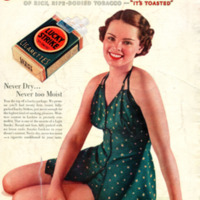Fashion and Elitism Advertisements
To further encourage smoking, advertisements used attractive debutants, singers, actresses, and women physicians to endorse cigarette products, but the main emphasis was on the fashion and elite status of the promoters. Many ads featured a fashionable, thin, upper class Caucasian woman, sometimes holding a cigarette. Advertisements aimed to appeal to the domestic lifestyle of women.[1] Indeed, Virginia Ernster states: “Although only the elite in the developing world can consume in a truly Western manner, cigarettes fulfill this promise in an inexpensive form. Appeals to Western images to emancipated women are combined with the lure of the modern consumer lifestyle. The linking of women’s emancipation with an addictive product is deliberate.”[2] Lucky Strike incorporated celebrities, and elitists to help promote the cigarettes by popularizing the image of a fashionable, upper class lady who, while smoking, still appeared stylish and respectable.[3] As a result, Lucky Strike campaigns incorporated fun-loving, sophisticated lifestyles by portraying golf, tennis, and yachting activities in the tobacco advertisements. During the Depression, these activities became more appealing to women when golf clubs were forced to allow female customers to maintain business.[4] The freedom for women to smoke was an inevitable development of the culture of consumerism, which was connected to the acquisition of material goods and mass production.
Although the upper-middle-class women were featured in the advertisements, feminine modernity in print media was also directed at the modern middle-class women. Since lower-class women were often addicted, smoking had a negative opinion among elite women, and health problems were becoming more conspicuous. In order to overcome the resistance, advertisers used fashionable, exotic, elite women in the advertisements to demonstrate the allure of cigarette smoking. Furthermore, nicotine was often used to keep women awake and alert, as well as physically attractive. It was used especially during high periods of stress and anxiety, as it helped provide a calming effect, and enabled better control of emotions.[5] A major element of the image of the social elite, was the sophistication of women who drank and smoke cigarettes, despite the taboos that had inhibited such behaviour prior to 1929. Smoking became a trademark for emancipation and modernity, and cigarette advertisements directed at women became commonplace in the 1930s: “Confident and sophisticated fashion models reinforced the centrality of the cigarette to the interwar feminine modernity.”[6] The women in the advertisements, particularly after 1934, were often holding a cigarette or resting their hands on a cigarette package. Ultimately, women say cigarettes as symbols of freedom, a sign they were their own person, going beyond society’s narrow roles and notions of liberation.[7] Indeed, these young fashion-conscious women represented the modern notion of womanhood, and emphasized personal pleasure, individualism, and independence, concerning themselves with appearance and hygiene.[8]
A Close Look:
Women in the advertisements were often the ideal image, or what the ‘average’ woman hoped to be. However, the ads focused predominantly on women that were of upper-class status since that is the audience it was hoping would become interesting in consuming cigarettes, perhaps since the Great Depression dampened the economy and only certain classes of women could afford to become frequent smokers. Nonetheless, women had a tough time with the identity aspect of society, which was purported in the ads: “Young women have been expected to be smart and responsible and to demonstrate leadership, while being thin, pretty, and smartly dressed in the latest fashions. The stress endured by virtually all young women along with their older sisters, mothers, and aunts cries out for relief. For many, that relief has been found in the cigarette.”[9] The campaigns that supported the Fashion and Elitism were: “High Fashion” and “Do You Inhale?” For the latter, the advertisements often promoted a more sexual appeal of the woman, who was often wearing high-end clothes, while laying down having a conversation with a man while smoking. The purpose of asking about inhaling was because it was believed that Lucky Strikes were safe enough to inhale the smoke, unlike most other brands. The more dominant campaign was the “High Fashion,” which was mainly significant for its choice of colour used in the advertisements.
There was widespread concern among female consumers due to the colour of the Lucky Strike cigarette package, thus, rather than changing the product, Bernays and Hill sought to transform the mindset of the women. As a result, Lucky Strike engaged in a “Green Campaign,” which was especially noticeable in the images within the category of fashion and elitism. The reason being is that the women saw green as unfashionable and unfeminine, often rejecting the use: “This green colour was problematic because survey research found that women did not buy Lucky Strikes because the green packaging clashed with their wardrobes.”[10] Hill requested for Bernays to resolve the problem by spending millions to advertise the signature green package, trying to find a way to manipulate women into liking the colour, as Hill was set against changing it. Bernays developed a campaign within the “High Fashion” campaign to get women to wear the colour green to prevent Lucky Strike packages from clashing with their outfits. The promotion went on for 6 months, whereby women were encouraged to wear green to match the packages. Since green was often associated with hope, victory, and colour, the goal was to make it a fashionable colour for women. For example, different ads would incorporate all green outfits; others would have a stool or something that is green all of which was done to promote the colour as fashionable and suitable for elitist, but also desirable for many others. A Green Ball was held in 1934, aimed at promoting the colour further, which helped establish the acceptability of the colour green.[11] The promotion of the colour green was not merely targeted at wardrobe, but rather it was depicted as a suitable colour to have in any woman’s life: “The promotion of green was a finely crafted public relations campaign, one that depended on well crafted and skillfully executed events.”[12] Bernays further targeted the fashion and accessories industries and department stores to encourage designers to use the colour green.
Furthermore, the advertisements evoked a sense of elitism due to their nature and representation of upper class women within the different Lucky Strike campaigns, yet it was not always successful in its aims: “This elitist tone suggested the glamour of smoking but proved misguided as a means of approaching bold, active women who wee claiming their rights to the same smoking (and other) pleasures enjoyed by men.”[13] In addition, the Green Ball was also subject to criticism when people held it was a publicity stunt and was created to encourage women to smoke. The result was women suffered from smoking-related diseases since it increased the number of female smokers.[14] Though Bernays later spent years trying to undo damage and promote anti-smoking, the effects were already widespread making him the villain along with the American Tobacco Company. While women laid the groundwork for tobacco companies to advertise to the female smoker, the advertisements changed the dynamic of the standards of society and norms. The fashion and elite appeal of smoking remained dominant, despite its shortcomings.
[1] Phyllis Marie Jensen, “A History of Women and Smoking.” Canadian Women Studies Vol. 14 No. 3 (1994): 29, https://cws.journals.yorku.ca/index.php/cws/article/view/9758
[2] Virginia Ernster, Nancy Kaufman, Mimi Nichter, Jonathan Samet, and Soon Yoon, “Women and Tobacco: Moving from Policy to Action,” World Health Organization Vol. 78 No. 7 (2000): 884, https://go.galegroup.com/ps/retrieve.do?tabID=T002&resultListType=RESULT_LIST&searchResultsType=SingleTab&searchType=AdvancedSearchForm¤tPosition=1&docId=GALE%7CA65229065&docType=Article&sort=RELEVANCE&contentSegment=&prodId=AONE&contentSet=GALE%7CA65229065&searchId=R1&userGroupName=otta77973&inPS=true
[3] Juliann Sivulka, Soap, Sex, and Cigarettes: A Cultural History of American Advertising (Boston, Massachusetts: Wadsworth, Cengage Learning, 2012), 149.
[4] Cheryl Krasnick Warsh, “Smoke and Mirrors: Gender Representation in North American Tobacco and Alcohol Advertisements Before 1950,” Social History Vol. 31 No. 62(1998): 205, https://hssh.journals.yorku.ca/index.php/hssh/article/view/4665
[5] Phyllis Marie Jensen, “A History of Women and Smoking.” Canadian Women Studies Vol. 14 No. 3 (1994): 31, https://cws.journals.yorku.ca/index.php/cws/article/view/9758
[6] Penny Tinkler and Cheryl Warsh, “FEMININE MODERNITY IN INTERWAR BRITAIN AND NORTH AMERICA: Corsets, Cars, and Cigarettes,” Journal of Women’s History Vol. 20 No. 3 (2008): 116, https://muse-jhu-edu.proxy.bib.uottawa.ca/article/251161
[7] Jensen, “A History of Women and Smoking.” 29.
[8] Phillip Scranton, Beauty and Business: Commerce, Gender, and Culture in Modern America (London: Routledge, Taylor & Francis Group, 2001), 76.
[9] Sharon A. Cook, Sex, Lies, and Cigarettes Canadian Women, Smoking, and Visual Culture, 1880-2000 (Montreal: McGill-Queen’s University Press, 2012) 208.
[10] Robert L. Heath, Encyclopedia of Public Relations (Los Angeles: SAGE Publications Inc., 2013), 524.
[11] Heath, Encyclopedia of Public Relations, 524.
[12] Heath, 524.
[13] Scranton, Beauty and Business, 78.
[14] Heath 525.
